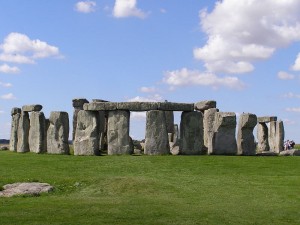UNITED KINGDOM — Modern celebrants have been convening at the ancient site of Stonehenge in Wiltshire for many years now: revivalist Druids of the early 20th century, hippies of the 1960s and 70s, New Age travelers and political activists, and modern Pagans have all gathered at the summer and winter solstices to hold free music festivals, conduct rituals, hold raves, and simply acknowledge the turning points of the year.

Stonehenge [Photo Credit: garethwiscombe/Flickr]
Beginning in 2015, the Human Henge Project is a mental health initiative run by a number of organizations. These include the Restoration Trust, the Richmond Fellowship, English Heritage, and Bournemouth University. It also has the support of the National Trust and the Avon and Wiltshire Mental Health Partnership -National Health Service. The project is being funded by the Heritage Lottery Fund, Wiltshire County Council and English Heritage.
The Restoration Trust itself helps people with mental health conditions engage with art and heritage via a process known as Culture Therapy. The Trust’s website reads:
Culture therapy’ helps people with mental health problems enjoy heritage, art and culture in a safe and effective way. We deliver projects in partnership with heritage/arts and health/social care bodies using resources and expertise from archives, archaeology, the historic environment, museums, visual art, music, creative writing and digital arts.
Culture therapy itself was developed in part by American academic Wil Gesler in the early 1990s, building on contemporary theory in the field of cultural ecology.
The Restoration Trust works with adults aged 18 and over, who live with a variety of mental health problems such as schizophrenia or bi-polar disorder, anxiety and depression. Some of the organization’s projects work exclusively with women, and some with people who live in supported housing.
One of the heritage-based projects has included Stonehenge. Human Henge Project spokesperson Laura Drysdale explains the power of this ancient landscape and the stone circle within it:
It’s a powerful space. If you’ve often felt excluded there is a symbolic power at being at the heart of one of the most important monuments in the world. You are invited in and it is yours. You are given the freedom to be there and muck about and play music and hug and love. Or just to watch the sun – it’s very potent.
Drysdale has also stated:
When people feel safe enough to take the enormous risk of embarking on a journey in both time and space, taking part in a strange wellbeing experiment in some fields, albeit fields that are among the most famous on the planet, with people they have never met, that’s when they may do things they never thought possible. It is when, hopefully, they can enjoy the richness of their own humanity… A group experience of a historic landscape illuminated by people who know about it open ups multiple vistas of temporal, topographical and psychological space. It is a short cut to the imagination.
This year, project participants were guided around the landscape over the course of 10 weeks by museum curators and musicians. During that time, they were introduced to the ways of the ancient people who lived there, such as baking bread and making clay pots. Bearing out Drysdale’s comments on the imagination, the project experience has generated creativity among its participants, some of whom have written poems about their time at Stonehenge.
One of the participants, who asked not to be named, said, “Projects like Human Henge are very rare, which is such a shame, because they are very effective.”
The participant went on to say that he had been in contact with mental health services for more than 30 years and that the Human Henge Project has allowed him to find his lost confidence.
From day one of the project there was an objective, a reason for being there. For others, and myself it was not about mental health or treatment, although it is important, it was about learning and getting private time in the stones. None of us knew that we would be forced to sing or walk for miles but these were some of the best fun we had.
Another participant with Bipolar Disporder adds, “An offer came up to do the Human Henge project and I jumped at the chance. I knew that we would have some time to spend inside Stonehenge alone, and I couldn’t wait to take part. It was a wonderful experience. It has all had a very beneficial effect on me.”
In a report, Bournemouth University professor Timothy Darvill told English Heritage:
We felt that Stonehenge would be a good venue for researching the development of therapy that might benefit those with mental illness and improve general well-being. The idea that in prehistoric times Stonehenge was a healing center and a focus for pilgrimage, can be traced back to medieval texts telling us that the stones were brought to Stonehenge because of their supposed magical powers – as healing stones. This was a nice historical note to start from, but when we began our research Geoff Wainwright (an archaeologist specializing in prehistory) and I found that the sources of the stones in the Preseli Hills in Southwest Wales were associated with the holy wells and springs which are considered to have healing properties. So we had this interesting coincidence of the same stories being present in the hills where the stones came from and also Stonehenge itself.
The Human Henge project is ongoing and, in January 2018, will be extended to the stone circle of Avebury. For a second time, a site that is the focus of regular modern Pagan worship, similar to Stonehenge, will now provide space for a significant and reportedly successful mental health initiative.
The Wild Hunt is not responsible for links to external content.
To join a conversation on this post:
Visit our The Wild Hunt subreddit! Point your favorite browser to https://www.reddit.com/r/The_Wild_Hunt_News/, then click “JOIN”. Make sure to click the bell, too, to be notified of new articles posted to our subreddit.